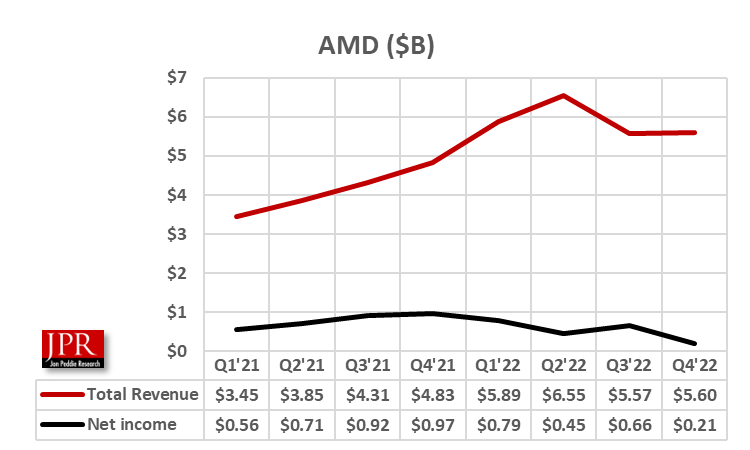
AMD reported fourth-quarter and fiscal-year 2022 results, and its numbers mirror the trend we saw with Intel last week, which would lend credence to Intel’s claims of macroeconomic headwinds.
For the fourth quarter ended December 31, 2022, AMD reported revenue of $5.6 billion, a 16% increase over the fourth quarter of 2021. Net income was just $21 million, a 98% decline from the $974 million of Q4’21. EPS was $0.01, down 99% from $0.80 EPS in Q4’21.
For the year, AMD reported revenue of $23.6 million, a 44% increase over the $16.4 million of FY’21. Net income was $1.32 billion, down 58% from the $3.16 billion in FY’21. EPS was $0.84, down 67% from the $2.57 EPS of FY’21.
“2022 was a strong year for AMD as we delivered best-in-class growth and record revenue despite the weak PC environment in the second half of the year,” said AMD Chair and CEO Dr. Lisa Su in an earnings call. “We accelerated our data center momentum and closed our strategic acquisition of Xilinx, significantly diversifying our business and strengthening our financial model. Although the demand environment is mixed, we are confident in our ability to gain market share in 2023 and deliver long-term growth based on our differentiated product portfolio.”

Non-GAAP Q4 gross margin was 51%, an increase of 1 percentage point year over year, primarily driven by higher Embedded and Data Center segment revenue, which offsets weakness in the Gaming and Client businesses.
Client sales were down 51% year over year due to reduced processor shipments resulting from a weak PC market and significant inventory correction across the PC supply chain, Su said. The Client segment posted an operating loss of $152 million compared to operating income of $530 million a year ago.
Gaming segment revenue was $1.6 billion, down 7% year over year due to lower gaming graphics revenue, partially offset by higher semiconductor product sales. Gaming operating income was $266 million, or 16% of revenue, compared to $407 million a year ago. The decrease was primarily due to lower graphics revenue, Su said.

Operating loss was $149 million, compared to operating income of $1.2 billion, or 25% of revenue a year ago. The loss was primarily due to the amortization of intangible assets associated with the Xilinx acquisition. Non-GAAP operating income was $1.3 billion, or 23% of revenue, compared to $1.3 billion, or 27%, a year ago. The non-GAAP operating margin decline was primarily due to lower Client segment operating income.
Net income was $21 million compared to net income of $974 million a year ago primarily due to the amortization of intangible assets associated with the Xilinx acquisition, partially offset by a $154 million tax benefit in the quarter. Non-GAAP net income was $1.1 billion, flat from a year ago.
Data Center was the star of the quarter
Data Center segment revenue was $1.7 billion, up 42% year over year, primarily driven by strong sales of Epyc server processors. Operating income was $444 million, or 27% of revenue, compared to $369 million, or 32%, a year ago. The operating income increase was primarily driven by higher revenue, partially offset by higher R&D investments to support growth. The operating margin decrease was primarily due to higher R&D investments to support growth.
The Q4 Data Center figures were driven by Epyc sales to cloud providers and North American hyperscalers, where sales more than doubled year over year as hyperscale customers continued moving more of their internal workloads and external instances to Epyc processors, Su said.
Client segment revenue was $903 million, down 51% year over year due to reduced processor shipments resulting from a weak PC market and a significant inventory correction across the PC supply chain. Client processor ASP was flat year over year. Operating loss was $152 million, compared to operating income of $530 million, or 29% of revenue, a year ago primarily due to lower revenue.
Gaming segment revenue was $1.6 billion, down 7% year over year, driven by lower gaming graphics sales partially offset by higher semi-custom product revenue. Operating income was $266 million, or 16% of revenue, compared to $407 million, or 23%, a year ago. The operating income and margin decreases were primarily due to lower graphics revenue.
AMD’s Embedded segment results
Embedded segment revenue was $1.4 billion, up 1,868% year over year, primarily driven by the inclusion of Xilinx embedded revenue. Operating income was $699 million, or 50% of revenue, compared to $18 million, or 25%, a year ago. The operating income and margin increases were primarily driven by higher revenue.
All Other operating loss was $1.4 billion compared to $117 million a year ago primarily due to amortization of intangible assets largely associated with the Xilinx acquisition.
Current outlook
For the first quarter of 2023, AMD expects revenue to be approximately $5.3 billion, plus or minus $300 million, a decrease of approximately 10% year over year. Year over year the Client and Gaming segments are expected to decline, partially offset by Embedded and Data Center segment growth. AMD expects non-GAAP gross margin to be approximately 50% in the first quarter of 2023.
AMD expects to continue to ship Client processors below consumption levels in the first quarter to reduce downstream inventory. The company believes its Embedded and Data Center businesses are well positioned to grow revenue and gain share in 2023. Su added they see elevated levels of inventory with some cloud customers, which will lead to a softer first half and a stronger second half of the year.
Changing of the guard
On January 11, AMD announced longtime CFO Devinder Kumar will be retiring from the company. Kumar will remain at AMD through April 2023 to ensure a smooth transition. His replacement is Jean Hu, who has been CFO of Marvell Technology since 2016. Hu joined AMD on January 23. She holds a doctorate in economics from Claremont Graduate University.





